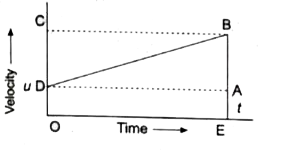Saved Bookmarks
| 1. |
In a free fall the velocity of a stone is increasing equally ion equal intervals of time under the effect of gravitational force of the earth. Then what can you say about the motion of this stone? Whether the stone is having: |
|
Answer» -uniform acceleration Let us try to derive these equations by graphical method.Equations of motion from velocity-time graph:  Graph shows the change in velocity with time for an uniformly accelerated object. The object starts from the point D in the graph with velocity u. Its velocity keeps increasing and after time t it reaches the point B on the graph . The initial velocity of the object =u = OD = EA The final velocity of the object =v=OC = EB Time = t= OE = DA Also from the graph we know that , AB=DC For first equation of motion By definition,acceleration =change in velocity / time =(final velcity -initial velocity ) / time =(OC-OD)/OE=DC/OE a=DC/t DC=AB=at From the graph EB=EA+AB v=u+at ....(1) This is first equation of motion. For second equationof motion From the graph the distance covered by the object during time t is given by the area of quadrangle DOEB s=area of the quad-rectangel DOEB s=area of the rectangle DOEA + area of the triangle DAB =(AE x OE) + (1/2 x AB x DA) `s=ut+1//2 at^2`. ...(2) This is second equation of motion. For Third equation of motion From the graph the distance covered by the object during time t is given by the area of the quadrangleDOEB . Here DOEB is a trapezium . Then s=area of trapezium DOEB =1/2 x sum of length of parallel side x distance betweenparallel sides =1/2 x (OD +BE) x OE s=1/2 x (u+v) x t since a =(v-u)/t or t=(v-u)/a THEREFORE s=1/2 x (v+u) x (v-u)/a `2as=v^2-u^2` `v^2=u^2+2as` ....(3) This is third equation of motion. |
|
Discussion
No Comment Found
Related InterviewSolutions
- A uniform cylindrical body when placed in liquid a floats with one third of its length outside the liquid. When placed in liquid B, it floats with one third of its length immersed in the liquid. When the body is made to float vertically in a homogeneous mixture of equal volumes of the two liquids, 25 cm of its length is seen in air. Find the length of the body.
- The place of human being in food chainin an ecosystem is as a:
- The velocities of sound waves in four media P,Q,R and S are 18,000 km//h, 900 km//h, 0km//h, and 1200 km/h respectively. Which medium could be a liquid substance?
- Calculate the wavelength of a sound wave whose frequency is 220Hz and speed is 440 m/s in a given medium.
- A metallic sphere is made of an alloy of metels 'P' and 'Q' having specific gravities (or relative densities) 20 and 2, respectively. The sphere weighs 120 g_(wt) in air and 90 gwt in water. Find the percentage of the mass of metal 'P' in the alloy.
- State whether the following statements are true or false: (a) A falling stone also attracts the earth. (b) The force of gravitation between two objects depends on the nature of medium between them. The value of G on the moon is about one-sixth((1)/(6)) of the value of G on the earth. (d) The acceleration due to gravity acting on a freely falling body is directly proportional to the mass or the body.The weight of an object on the earth is about one-sixth of its weight on the moon.
- A body of density rho is immersed in a liquid of density rho_(L).State condition when the body will (i) float (ii) sink in liquid.
- The speed-time graphs for three objects X, Y and Z are represented on the same graph paper. Which object would cover the highest distance in given interval of time (t)?
- For a given glass prism, as the angle of incidence increases, theangle of emergence __________ .
- Calculate the potential difference across the ends of a wire of resistance 2 Omega' when a current of 1.5 A passes through it.